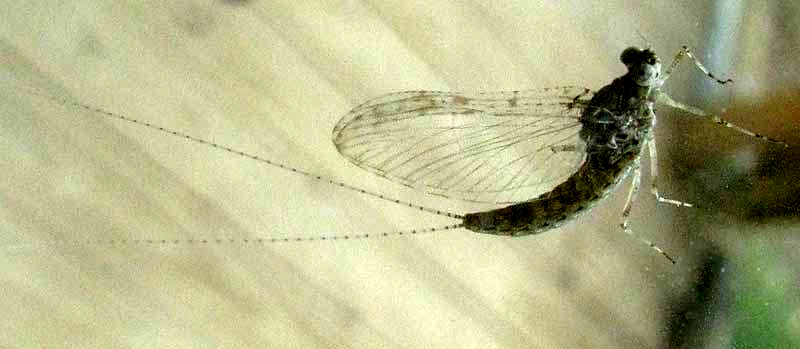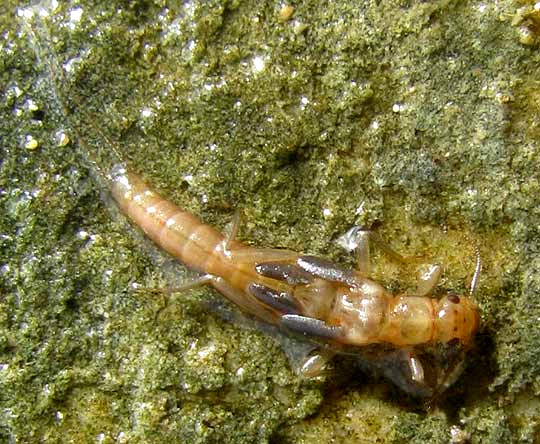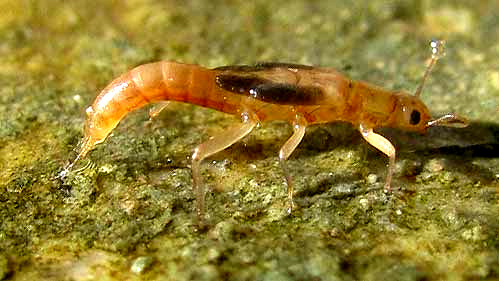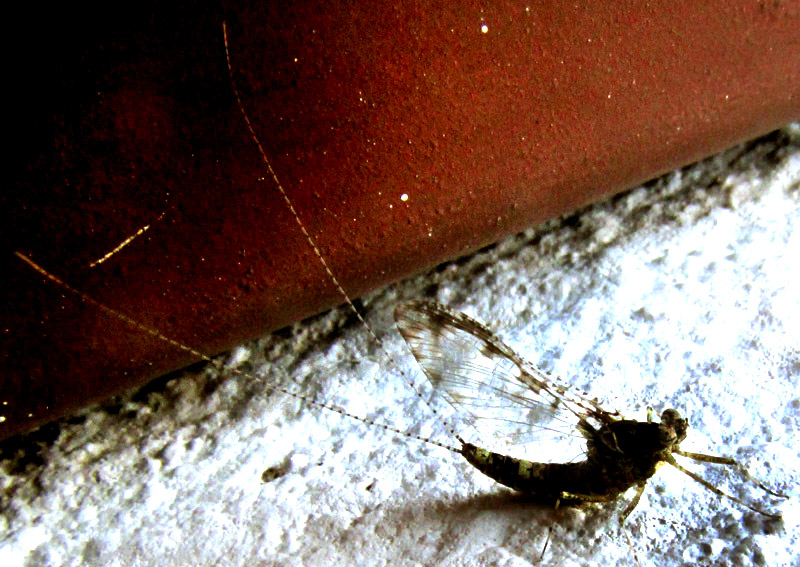Excerpts from Jim Conrad's
Naturalist Newsletter

from the October 27, 2013 Newsletter issued from the Frio Canyon Nature Education Center in the valley of the Dry Frio River in northern Uvalde County, southwestern Texas, on the southern border of the Edwards Plateau; elevation ~1750m (~5750 ft); N29.62°, W99.86°; USA
SPECKLED DUN MAYFLY
A surprisingly small mayfly mysteriously turned up in my room, perched on a vertical glass window, as shown above. I had little hope that volunteer identifier Bea in Ontario could figure this one out, but I sent the picture to her anyway. At first she doubted she could do anything with it, pointing out that "Currently 110 nominal species of mayflies are reported for Texas, distributed in 12 families and 40 genera."
However, BugGuide.Net's Mayfly Page was helpful. Insect identifier Bea in Ontario thinks we have CALLIBAETIS PICTUS, often known as the Speckled Dun. It's reported as widespread in western North America and Mexico, and has been collected in Costa Rica as well, so there's no reason for it not to be here.
A very interesting quirk of this genus {Callibaetis} is evidence that suggests the tiny nymphs hatch from fertilized eggs almost as soon as they hit the water. To make this possible, the females would have to wait on land for an extended period after mating to allow incubation before they can oviposit.
It's gratifying that fly fisherfolks are so interested in the kinds of insects their fish eat, and which they can use when fly-fishing
from the January 19, 2014 Newsletter issued from the Frio Canyon Nature Education Center in the valley of the Dry Frio River in northern Uvalde County, southwestern Texas, on the southern border of the Edwards Plateau; elevation ~1750m (~5750 ft); N29.62°, W99.86°; USA
LARVA BENEATH A ROCK
In most places the Dry Frio's streambed consists of cobblestones. Sometimes the stream flows over or between the stones, and sometimes it disappears into cobblestone bars to reemerge downstream. Nowadays if you turn over cobblestones where the water is very shallow, you'll find clinging beneath them slender, whitish, half-inch long (13mm) critters looking like what's shown below:

It's the larva of an insect that during its adult stage will bear four wings, as indicated by the four dark wing-buds on the larva's back. A side view of the same larva appears below:

The immature form of an insect that undergoes incomplete or gradual metamorphosis before reaching its adult stage is called a nymph. Complete metamorphosis consists of
egg --> larva--> pupa--> adult
But during incomplete metamorphosis it's
egg --> nymph --> adult
The nymph grows through a series of gradual changes and often is similar to the adult, except that it's smaller and lacks wings and functional reproductive organs. The aquatic nymphs of dragonflies, damselflies, stoneflies and mayflies can also be called naiads. Our picture shows a naiad, since volunteer identifier Bea in Ontario pegs what's shown as a mayfly nymph. About 110 mayfly species are listed for Texas, distributed in 12 families and 40 genera, so we're not sure what kind of mayfly nymph this is. However, earlier we identified the Speckled Dun Mayfly in the Dry Frio, which produces a slender nymph like ours, so that species would be a good bet.
Mayfly nymphs do come in a wide variety of shapes, as shown on a University of Iowa Limnology page.
Among the adaptations of our mayfly nymph enabling it to cling to the bottom of cobblestones in runny water is its somewhat flattened body that reduces the water's pull, legs spread to the sides and ending in claws enabling the nymph to hold onto the rock better, and eyes on the back of the head, enabling the nymph to advance through muck and sand without damaging the eyes. Some mayfly nymphs are streamlined like fish, enabling them to swim, and others have strong front legs and upturned tusks near their mouthparts enabling them to burrow through silt and sand.
Entry dated May 5, 2024, issued from near Tequisquiapan; elevation about 1,900m, (6200 ft), ~N20.57°, ~W99.89°; Querétaro state, MÉXICO
SPECKLED DUN MAYFLY IN CENTRAL MEXICO

During an enduring extreme drought, two days after a modest shower, the above mayfly turned up on the white, morning-sunlight-facing wall of a house at the edge of a village surrounded by an extremely parched, dead-looking landscape vegetated with mesquite-dominated scrub. One wonders where a mayfly can come from. It seemed uninterested in moving when a camera was placed near. In the picture, the rusty-red item at the top of the edge of a door.
As mentioned earlier, Callibaetis pictus has been collected as far south as Costa Rica, so it's presence here is not unexpected. But its appearance in such a dry environment certainly is.